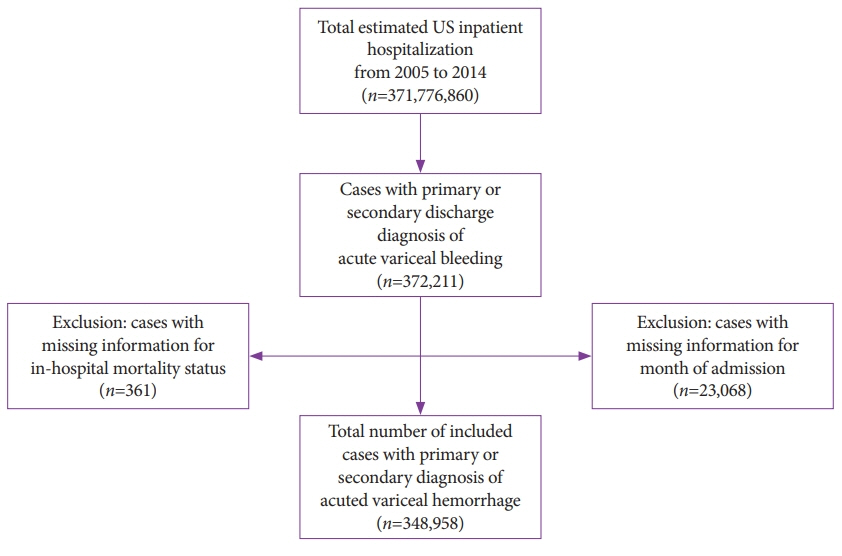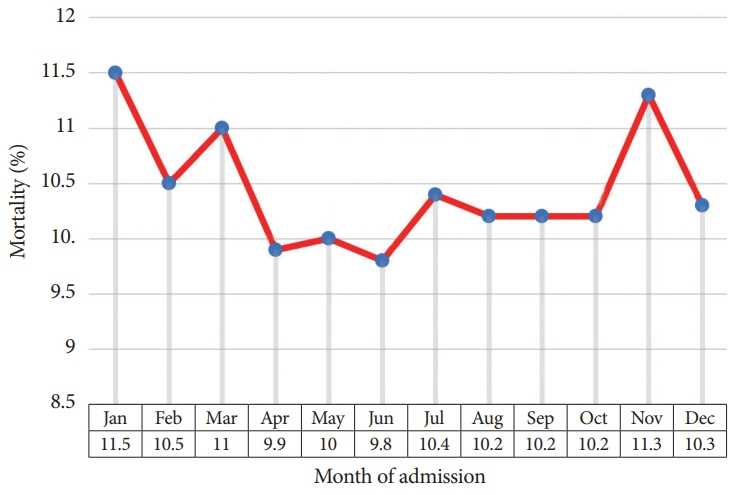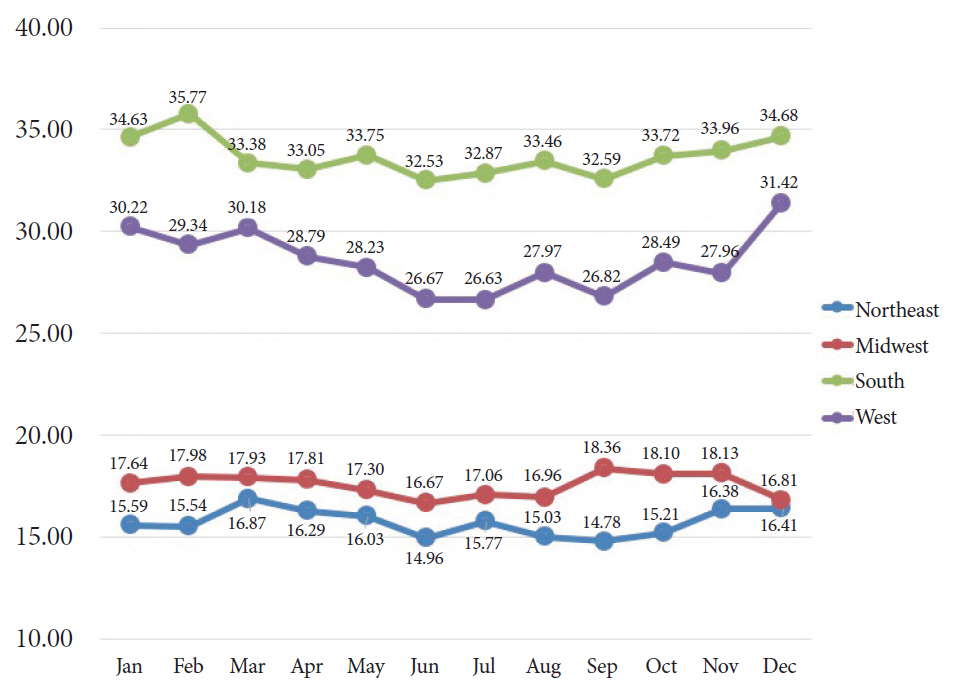Clin Endosc.
2020 Mar;53(2):189-195. 10.5946/ce.2019.094.
Seasonal Impacts on the Incidence of Esophageal Variceal Hemorrhage: A Nationwide Analysis across a Decade
- Affiliations
-
- 1Department of Gastroenterology and Hepatology, Center for Human Nutrition, Digestive Disease and Surgery Institute, Cleveland Clinic, Cleveland, OH, USA
- 2Department of Gastroenterology, Beth Israel Deaconess Medical Center, Boston, MA, USA
- 3Department of Gastroenterology, Henry Ford Medical Center, Detroit, MI, USA
- 4Department of Internal Medicine, New York Medical College, Valhalla, NY, USA
- 5Department of Gastroenterology, New York Medical College, Valhalla, NY, USA
- KMID: 2500886
- DOI: http://doi.org/10.5946/ce.2019.094
Abstract
- Background/Aims
Seasonal variation has previously been reported in relation to the incidence of non-variceal upper gastrointestinal bleeding; however, the impact of seasonal variation on variceal bleeding is not known.
Methods
We conducted a cross-sectional study using the Nationwide Inpatient Sample database from 2005 to 2014. International Classification of Diseases, Clinical Modification- 9th Revision codes were used to identify patients hospitalized with a primary or secondary diagnosis of esophageal variceal hemorrhage. The data were analyzed based on the month of hospitalization. Our primary aim was to assess seasonal variations in variceal bleeding-related hospitalizations. The secondary aims were to assess the impact of seasonal variation on outcomes in variceal bleeding including in-hospital mortality and healthcare resource utilization.
Results
A total of 348,958 patients hospitalized with esophageal variceal bleeding were included. The highest number of hospitalizations was reported in December (99.3/day) and the lowest was reported in June (90.8/day). In-hospital mortality was highest in January (11.5%) and lowest in June (9.8%). There was no significant difference in hospital length of stay or total hospitalization costs across all months in all years combined.
Conclusions
There appears to be a seasonal variation in the incidence and mortality of variceal hemorrhage in the United States. December was the month with the highest number of daily hospitalizations while the nadir occurred in June.
Keyword
Figure
Cited by 1 articles
-
Are there Seasonal Variations in the Incidence and Mortality of Esophageal Variceal Bleeding?
Jeong Ill Suh
Clin Endosc. 2020;53(2):107-108. doi: 10.5946/ce.2020.042.
Reference
-
1. Jansen PL. Life expectancy in liver cirrhosis after the first variceal hemorrhage: how can survival be improved? Scand J Gastroenterol Suppl. 1990; 178:106–110.
Article2. Sempokuya T, Zhang G, Nakagawa K. Temporal trends of cirrhosis associated conditions. World J Hepatol. 2019; 11:74–85.
Article3. Myers RP, Papay KD, Shaheen AA, Kaplan GG. Relationship between hospital volume and outcomes of esophageal variceal bleeding in the United States. Clin Gastroenterol Hepatol. 2008; 6:789–798.
Article4. Le Moine O, Hadengue A, Moreau R, et al. Relationship between portal pressure, esophageal varices, and variceal bleeding on the basis of the stage and cause of cirrhosis. Scand J Gastroenterol. 1997; 32:731–735.5. Wang F, Cui S, Wang F, et al. Different scoring systems to predict 6-week mortality in cirrhosis patients with acute variceal bleeding: a retrospective analysis of 202 patients. Scand J Gastroenterol. 2018; 53:885–890.
Article6. Abougergi MS, Travis AC, Saltzman JR. The in-hospital mortality rate for upper GI hemorrhage has decreased over 2 decades in the United States: a nationwide analysis. Gastrointest Endosc. 2015; 81:882–888.e1.
Article7. Fares A. Global patterns of seasonal variation in gastrointestinal diseases. J Postgrad Med. 2013; 59:203–207.
Article8. Ostensen H, Gudmundsen TE, Burhol PG, Bonnevie O. Seasonal periodicity of peptic ulcer disease. A prospective radiologic study. Scand J Gastroenterol. 1985; 20:1281–1284.9. Sezgin O, Altintaş E, Tombak A. Effects of seasonal variations on acute upper gastrointestinal bleeding and its etiology. Turk J Gastroenterol. 2007; 18:172–176.10. Stermer E, Levy N, Tamir A. Seasonal fluctuations in acute gastrointestinal bleeding. J Clin Gastroenterol. 1995; 20:277–279.
Article11. Jamal MM, Samarasena JB, Hashemzadeh M, Vega KJ. Declining hospitalization rate of esophageal variceal bleeding in the United States. Clin Gastroenterol Hepatol. 2008; 6:689–695. quiz 605.
Article12. Quan H, Sundararajan V, Halfon P, et al. Coding algorithms for defining comorbidities in ICD-9-CM and ICD-10 administrative data. Med Care. 2005; 43:1130–1139.
Article13. Southern DA, Quan H, Ghali WA. Comparison of the Elixhauser and Charlson/Deyo methods of comorbidity measurement in administrative data. Med Care. 2004; 42:355–360.
Article14. Yen FS, Wu JC, Wang LM, Kuo BI, Hu SC, Lee SD. Seasonal variation in the incidence of peptic ulcer and esophageal variceal bleeding in Taiwan. Zhonghua Yi Xue Za Zhi (Taipei). 1996; 57:22–27.15. Boulay F, Berthier F, Dahan MDC, Tran A. Seasonal variations in variceal bleeding mortality and hospitalization in France. Am J Gastroenterol. 2001; 96:1881–1887.
Article16. Adler J, Ingram D, House T. Perforated peptic ulcer--a seasonal disease? Aust N Z J Surg. 1984; 54:59–61.17. Mejía Cordero F, Mondragón Aguilar E, Montes Teves P, Monge Salgado E. [Seasonal variation in upper gastrointestinal bleeding associated with portal hypertension]. Rev Gastroenterol Peru. 2006; 26:278–282.18. Budzyński P, Pogoda W, Pogodziński M. [Seasonal variation and influence of atmospheric pressure diurnal fluctuations on occurrence of acute complications in patients with stomach and duodenal ulcer]. Przegl Lek. 2000; 57:611–613.19. Langman MI. The seasonal incidence of bleeding from the upper gastrointestinal tract. Gut. 1964; 5:142–144.
Article20. Kanotra R, Ahmed M, Patel N, et al. Seasonal variations and trends in hospitalization for peptic ulcer disease in the United States: a 12-year analysis of the nationwide inpatient sample. Cureus. 2016; 8:e854.
Article21. Carbonell N, Pauwels A, Serfaty L, Fourdan O, Lévy VG, Poupon R. Improved survival after variceal bleeding in patients with cirrhosis over the past two decades. Hepatology. 2004; 40:652–659.
Article22. Stokkeland K, Brandt L, Ekbom A, Hultcrantz R. Improved prognosis for patients hospitalized with esophageal varices in Sweden 1969-2002. Hepatology. 2006; 43:500–505.
Article23. De Lédinghen V, Heresbach D, Fourdan O, et al. Anti-inflammatory drugs and variceal bleeding: a case-control study. Gut. 1999; 44:270–273.
Article24. Ventura-Cots M, Watts AE, Cruz-Lemini M, et al. Colder weather and fewer sunlight hours increase alcohol consumption and alcoholic cirrhosis worldwide. Hepatology. 2019; 69:1916–1930.
Article25. Cooper GS, Chak A, Lloyd LE, Yurchick PJ, Harper DL, Rosenthal GE. The accuracy of diagnosis and procedural codes for patients with upper GI hemorrhage. Gastrointest Endosc. 2000; 51(4 Pt 1):423–426.
Article
- Full Text Links
- Actions
-
Cited
- CITED
-
- Close
- Share
- Similar articles
-
- The Use of Vasoconstrictors in Acute Variceal Bleeding: How Long Is Enough?
- Removal of a Trigger Cord Stuck between Bands during Endoscopic Multiple-Band Ligation for Treating Esophageal Variceal Hemorrhage
- Analysis of Seasonal Variation and Risk factors of Esophageal Variceal Bleeding in Patients with Cirrhosis
- A Case of Esophageal Perforation during Endoscopic Variceal Ligation
- Endoscopic Therapy and Radiologic Intervention of Acute Gastroesophageal Variceal Bleeding





